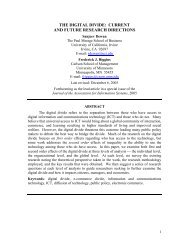When Should Software Firms Commercialize New Products ... - MISRC
When Should Software Firms Commercialize New Products ... - MISRC
When Should Software Firms Commercialize New Products ... - MISRC
Create successful ePaper yourself
Turn your PDF publications into a flip-book with our unique Google optimized e-Paper software.
9 Conclusions<br />
Inthis paper, we providean extensive head-on comparison between theconventional charge-<br />
for-everything business model and several freemium and seeding models extant in software<br />
markets. Our models are based on an integrated framework capturing multi-period adop-<br />
tion dynamics, network externalities, customer valuation learning, and software modularity.<br />
This allows us to conduct previously unexplored comprehensive performance benchmark-<br />
ing among models and to derive policy implications. Moreover, our analysis sheds more<br />
light on various marketing approaches employed in the software industry. For one, CE,<br />
TLF, and FLF can each be a dominating strategy for the firm, depending on consumer<br />
priors on the value of individual software modules, perceptions of cross-module synergies,<br />
and overall value distribution across modules, whereas uniform seeding is always dominated<br />
by either freemium models or conventional for-fee models. Our analysis offers significant<br />
managerial insights, as we show that switching from CE model to freemium models can<br />
dramatically increase profitability, as can switching between different freemium models. Fi-<br />
nally, we show that freemium is always preferred from the society’s perspective, and derive<br />
recommendations as to when the firm needs to be subsidized in order for the social welfare<br />
to be increased.<br />
Given that the goal of this study is to seek insights by comparing and contrasting sev-<br />
eral established business models, our framework was stylized for tractability. This presents<br />
opportunities for our analysis to be extended in multiple ways, perhaps using simulations or<br />
other numerical approaches when closed-form solutions like ours cannot be derived. First,<br />
throughoutthisstudy, wefocussedonsoftwareproductscharacterized byone-timepurchase,<br />
where the users run the software off their own machines and the developer does not invest<br />
additional resources to support the consumption of the product. For simplicity we do not<br />
consider quality improvement and maintenance via patching. However, as discussed in the<br />
Introduction, freemium applicability extends beyond such products, in particular branching<br />
into the rapidly growing markets for software-as-a-service products, where adoption dynam-<br />
icsareslightly differentandtherevenuemodelisinmanycasessubscription-based,involving<br />
recurring payments from the installed base. In such markets, service providers may incur<br />
non-negligible operational costs associated with running the application (on own hardware<br />
infrastructure or on stable environments sourced from platform-as-a-service providers such<br />
28
















